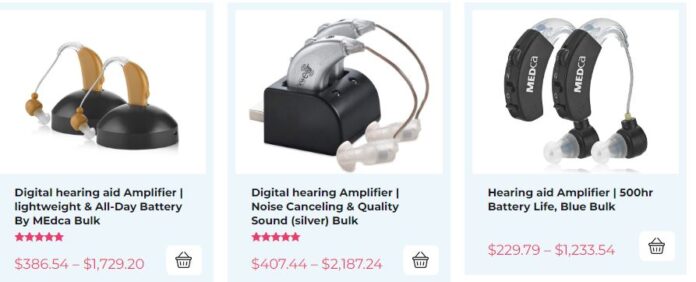Hearing loss not only takes our listening power but also makes us feel isolated, frustrated, and even overwhelmed. Missing out on conversations with our loved ones or getting the urge to listen to the sound of noisy traffic or people whispering around us makes us feel disconnected from the world; the impact of hearing loss is profound. But the good news is that hearing aids have come a long way in recent years, offering life-changing solutions for those with hearing challenges. If you’re ready to say goodbye to silence and embrace a world of clear, vibrant sound, this guide will walk you through everything you need to know about buying hearing aids that truly transform your life.
Understanding hearing loss: The first step
Before diving into hearing aids, it’s important to understand your hearing loss. Hearing loss can range from mild to profound and can be caused by aging, exposure to loud noises, genetics, or medical conditions. The first step is to consult an audiologist or hearing professional. They will conduct a hearing test to estimate your level of hearing loss and recommend the best course of action.
Knowing the specifics of your hearing loss will help you make informed decisions about choosing the right hearing aids. For example, someone with mild hearing loss may need a different type of device than someone with severe hearing loss.
Types of hearing aids: Finding the right fit
Hearing aids come in various styles and technologies, each designed to meet different needs and preferences of the consumer. Here’s a quick overview of the most common types:
- Behind-the-Ear (BTE): These hearing aids sit behind the ear and are connected to an earpiece inside the ear canal. They’re suitable for all levels of hearing loss and are known for their durability and power.
- In-the-Ear (ITE): Custom-made to fit inside the outer ear, ITE hearing aids are sensitive and ideal for mild to severe hearing loss.
- In-the-Canal (ITC) and Completely-in-the-Canal (CIC): These are smaller and fit partially or completely inside the ear canal, making them nearly invisible. They’re best for mild to moderate hearing loss.
- Receiver-in-Canal (RIC): Similar to BTE hearing aids, RIC devices have a receiver inside the ear canal, offering a more natural sound experience.
When choosing a style, consider factors like comfort, ease of use, and how visible you want the hearing aids to be.
Key features to look for –
- Noise Reduction: This feature helps filter out background noise, making it easier to focus on conversations.
- Directional Microphones: These microphones strengthen sounds coming from a specific direction, which is especially useful in noisy environments.
- Bluetooth Connectivity: Many hearing aids now come with Bluetooth, allowing you to connect to smartphones, TVs, and other devices for seamless audio streaming.
- Rechargeability: Rechargeable hearing aids eliminate the hassle of constantly changing batteries.
Think about your lifestyle and daily activities when selecting features. For example, if you’re frequently on the phone or enjoy watching TV, Bluetooth connectivity might be a game-changer for you.
Where to Buy Hearing Aids –
Once you’ve narrowed down your options, it’s time to decide where to buy your hearing aids. Here are the main options:
- Audiologists or Hearing Specialists: Buying from a professional ensures you get personalized advice and proper fitting. They can also provide constant support and adjustments.
- Online Retailers: Many reputable online stores offer hearing aids at competitive prices. However, you’ll need to guarantee you have access to professional fitting and support.
- Big-Box Stores: Some retail chains offer hearing aids at lower prices, but the level of expertise and support may vary from one or another.
Regardless of where you buy, make sure the seller offers a trial period and a good warranty. Hearing aids are a significant investment, and you want to be confident in your purchase.
Overcoming Common Concerns –
It’s natural to have worries when buying hearing aids. Here are some common worries and how to address them:
- Cost: Hearing aids can be expensive, but many insurance plans now offer coverage. Additionally, some communities provide financial assistance for those in need.
- Adjustment Period: It can take time to get used to wearing hearing aids. Start by wearing them for a few hours a day and gradually increase usage.
- Stigma: Many people worry about how hearing aids will look. Fortunately, modern devices are sleek, discreet, and designed to blend in within your ear without any discomfort in your daily life.
The Life-Changing Benefits to buy Hearing Aids –
Investing in hearing aids isn’t just about improving your hearing—it’s about improving the quality of life you live in. Here are just a few ways hearing aids can change your life:
- Better Communication: Hear conversations clearly, whether you’re chatting with a friend or attending a meeting.
- Increased Confidence: Feel more confident in social situations, knowing you won’t miss out on important details.
- Improved Relationships: Strengthen your connections with loved ones by fully engaging in conversations.
- Enhanced Safety: Hear alarms, doorbells, car honks, and other important sounds that keep you safe.
Final Thoughts –
Purchasing hearing aids is a significant decision that can greatly improve your quality of life. By understanding your hearing loss, exploring available options, and selecting the right features, you can find a device that suits your needs and complements your lifestyle.
It’s important to consider the ongoing support and maintenance of your hearing aids. Many manufacturers provide warranties, repair services, and resources for effective use. Regular check-ups with your hearing specialist can help adjust settings, ensuring optimal performance. Embracing this technology can lead to improved hearing and enhanced relationships, allowing full engagement with the world around you.
Remember, you don’t have to go through this journey alone. Consult with a hearing specialist, ask questions, and take advantage of trial periods to ensure you’re making the best choice. With the right hearing aids, you can say goodbye to silence and hello to a world filled with sound, connection, and joy.
So, what are you waiting for? Begin your journey to better hearing today—your future self will be grateful.































